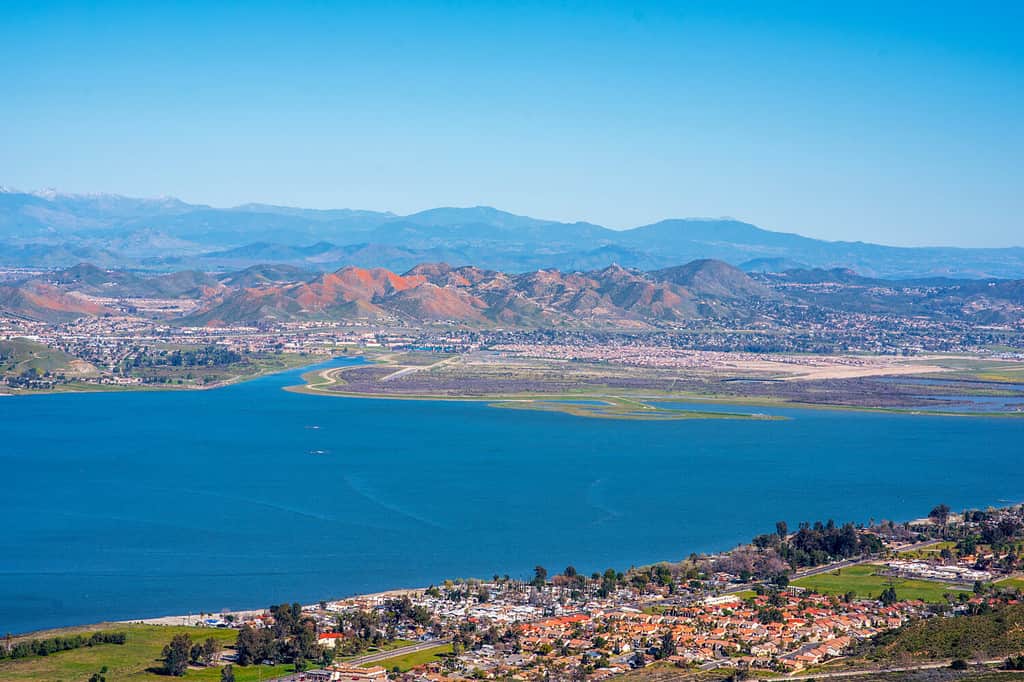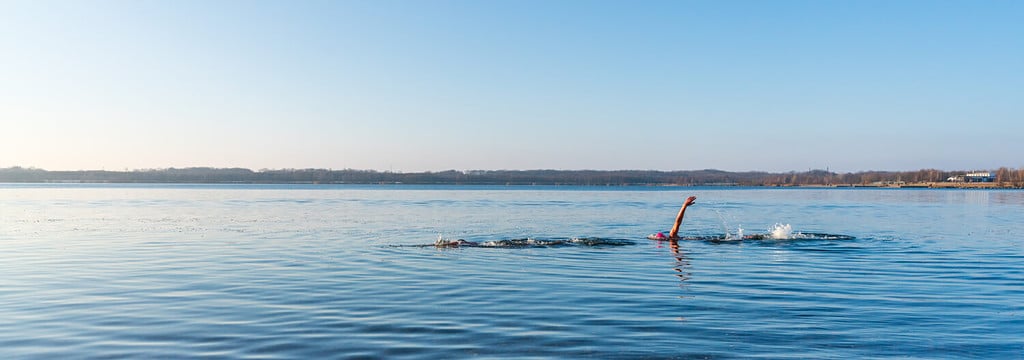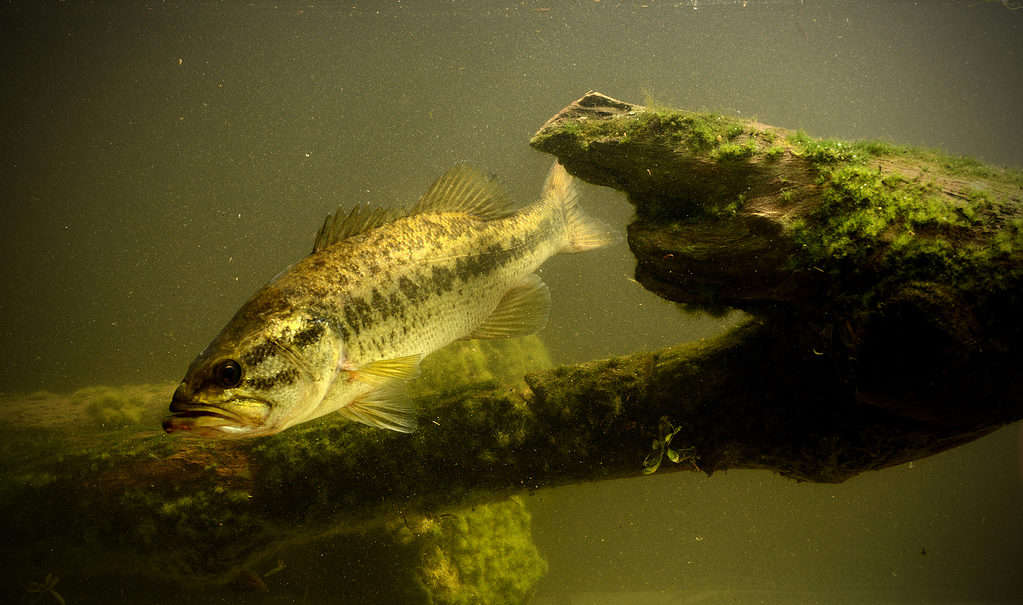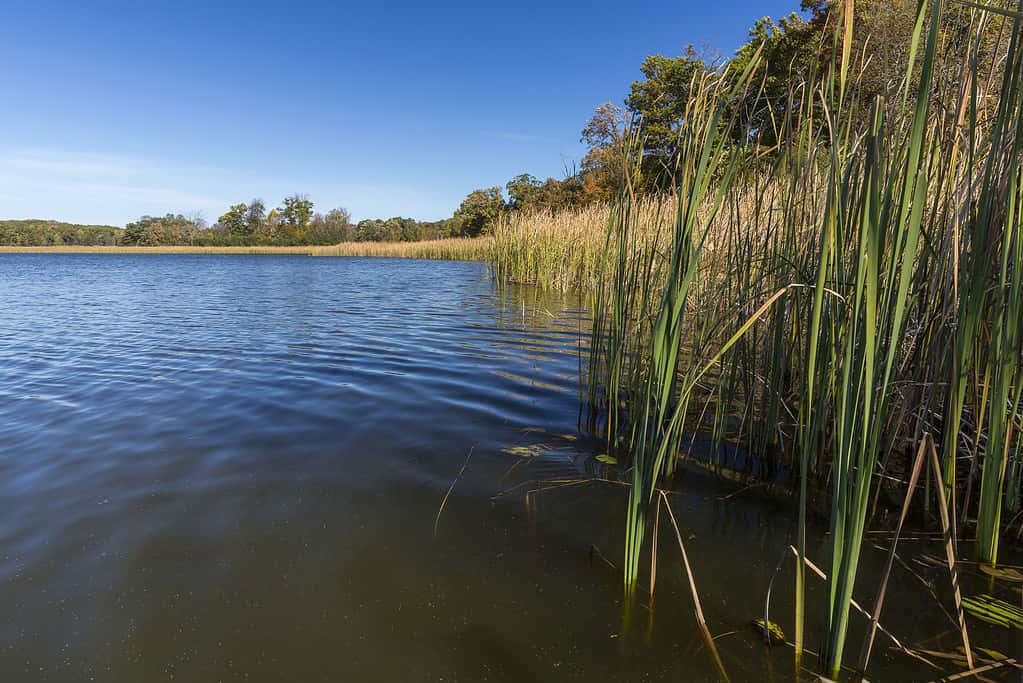Lake Elsinore is a captivating example of the delicate balance between nature and human stewardship. This body of water is known not only for its expansive beauty but also for its water quality issues. Against a backdrop of comprehensive conservation efforts, ongoing projects, and initiatives have been and continue to be implemented to improve water quality and the natural ecosystem. All-encompassing, what’s in Lake Elsinore, and is it safe to swim in? The following segments will dissect the various factors that address these questions.

Lake Elsinore is the largest natural freshwater lake in Southern California.
©iStock.com/Cavan Images
Where is Lake Elsinore Located?
Lake Elsinore resides in Southern California within Riverside County. It is a natural freshwater lake within Elsinore Valley, a graben rift valley part of the Elsinore Trough that has been gradually sculpted over many years by tectonic and climatic forces. In addition, the lake is adjacent to the city of Lake Elsinore. All of them share the same name, making them easy to remember! This geological reality is a foundational influence for what’s in Lake Elsinore and whether it is safe to swim in.
A Brief History
Between 1790 and 1810, travelers described the lake was described as swamp-like. By the 1850s, the lake had grown and taken shape. Between the 1850s and 1980s, the lake experienced an ongoing cycle of flooding and drought, significantly affecting its water levels, ecosystem, and the surrounding landscape. In the 1980s, a project was established to maintain consistent water levels of the lake. To combat fish kills and algae blooms in the lake, an aeration system was added in 2007.
Lake Elsinore boasts dimensions that are closely maintained by the Lake Elsinore and San Jacinto Watersheds Authority (LESJWA) to avoid excessive drought or flooding. Approximately five million gallons of treated recycled water from Elsinore Valley Municipal Water District’s Regional Water Reclamation Facility is deposited into the lake daily. The purpose of this is to offset evaporation. In addition, the Lake Elsinore Management Project has also helped reduce evaporation loss and flooding while improving water quality and recreation opportunities and enhancing fish and wildlife habitats. This has been achieved through various efforts, including using an earthen levee, providing controlled overflow points into the lake, creating new wetland habitats, drilling new wells, and creating an operations island and a causeway for well operations.
Lake Elsinore has roughly 14 miles of shoreline. Its surface area spans approximately 3,000 acres at normal levels and 3,450 acres at its fullest. The lake’s average depth is 27 feet, while its maximum depth reaches 42 feet. In terms of its length, Lake Elsinore stretches across approximately 6 miles, while its width extends to about 1.5 miles.

Lake Elsinore resides within Elsinore Valley, a graben rift valley part of the Elsinore Trough.
©Marie1969/Shutterstock.com
Is Lake Elsinore Safe to Swim In?
Beneath Lake Elsinore’s surface lies a complex interplay of water quality, seasonal fluctuations, and ecological dynamics. Next, we explore the safety concerns, water quality, and potential challenges that define Lake Elsinore. These factors will help us determine what is in Lake Elsinore and if it is safe to swim in.
Lake Elsinore has long been a destination for aquatic recreation. Its serene expanse and warm climate create an ideal setting for swimming and water-based activities. However, the safety of swimming in any natural body of water can warrant careful consideration, as conditions can vary. This is particularly true for Lake Elsinore. So, is Lake Elsinore safe to swim in? Yes and no, it depends on various ever-evolving factors.
Water Quality
While Lake Elsinore is a popular spot for swimming, boating, and other activities, it’s crucial to approach these activities with a mindful appreciation for the environment and safety guidelines. Lake Elsinore has its own 45-square-mile watershed. However, it is located at the lowest point within the 780 square mile San Jacinto River watershed at the end of the San Jacinto River. Due to its location, the lake has a history of pollution and nutrient issues due to runoff. This has caused a choking of the lake’s oxygen supply and has created an ideal environment for destructive and toxic algae blooms.
Thus, one of the critical factors that influence the safety of swimming in Lake Elsinore is, foremost, the water quality. The water quality of any natural body of water is subject to a myriad of factors, including runoff from surrounding areas, lake nutrient levels, temperature of the water and environment, and the presence of pollutants. The average water quality of Lake Elsinore can vary throughout the year due to these factors, with more issues arising during the warmer months of the year.
Pollution comes to mind when it comes to what’s in Lake Elsinore and if it is safe to swim in. Pollution issues can arise from any runoff sources, agricultural activities, and other human influences in the lake’s watershed. These pollutants can degrade water quality and impact the overall health of the aquatic ecosystem. Also, algae blooms, which can harm both humans and animals, are a factor to consider.
Algae Blooms
Moreover, of what’s in Lake Elsinore and if it is safe to swim in, algae, a natural component of aquatic ecosystems, can proliferate rapidly under certain conditions. Algae blooms, particularly those dominated by harmful species, can threaten the environment and human or animal health.
During warmer months, elevated temperatures and nutrient-rich waters can create conditions conducive to algae growth. Harmful algal blooms (HABs) can produce toxins that are hazardous to humans and animals. These toxins can lead to skin irritation, respiratory problems, and more severe health issues if ingested. Hence, it’s essential to be cautious and informed before swimming in the lake, particularly during periods when algae blooms are more prevalent.
Pollution Management
Efforts to mitigate pollution and manage water quality in Lake Elsinore are ongoing. Local and state authorities and conservation organizations have been working to address pollution sources, improve water treatment, and promote responsible land use practices in the lake’s watershed. These endeavors aim to enhance the lake’s overall water quality and safety for recreational use in addition to improving the ecosystem.
Now that we know what’s in Lake Elsinore, how can we determine if it is safe to swim in it? When it comes to swimming in the waters of Lake Elsinore or enjoying other water-based activities, timing can play a pivotal role in ensuring a safe and pleasant experience. The time of year when the risk of encountering algae blooms and poorer water quality is most heightened is typically during the warmer months, particularly late spring and summer. Elevated temperatures and nutrient levels can provide favorable conditions for algae growth during these periods. The city of Lake Elsinore provides up-to-date water quality reports and warnings on its website.
Lake Elsinore Water Quality in 2023
Overall, Lake Elsinore’s allure as a recreational destination is strong despite its ongoing management of pollution and algae issues. As of August 7th, 2023, the current levels of toxins from algae present in the water of Lake Elsinore are labeled as “Cautionary.” These results are concluded by the California State Water Board and provided by the city of Lake Elsinore. Under the “Caution” advisory, per the California State Water Resource Control Board, all forms of recreation are still permitted. However, people are advised to avoid contact with algae, not to drink the lake water, and keep pets out of the lake.
Furthermore, Lake Elsinore’s waters demand respect, caution, and consideration. While the lake offers opportunities for swimming and water-based activities, its water quality and conditions can vary due to various factors, including pollution, algae, and seasonal dynamics. Responsible enjoyment of the lake requires a thoughtful understanding of the environment, adherence to safety guidelines, and staying informed about potential risks, particularly during periods when algae blooms are more likely.

Lake Elsinore is a popular destination for water-based recreational activities, including swimming, boating, fishing, and more.
©DZiegler/Shutterstock.com
Animals Found in Lake Elsinore
Now that we’ve discussed whether Lake Elsinore is safe to swim, what’s in Lake Elsinore when considering animal species? There is diverse animal life and history within Lake Elsinore. Despite the ongoing issues with water quality, many animals have survived and thrived here. Large and small, water and land, they coexist in harmony. The lake’s waters are filled with diverse fish species. At the same time, its shores provide shelter for a mosaic of amphibians, reptiles, birds, and mammals.
Fish
Lake Elsinore’s aquatic environment includes an impressive variety of fish species. The diversity of fish species in Lake Elsinore underscores the delicate balance between native and introduced populations. Introduced species have helped improve the ecosystem and provide recreational opportunities such as fishing. Maintaining this balance requires careful management, conservation efforts, and consideration of the potential impacts on the ecosystem.
Efforts to protect native species and their habitats, restore ecological balance, and manage introduced species are ongoing. Collaborative initiatives involving governmental agencies, conservation organizations, and local communities strive to ensure that the fish populations in Lake Elsinore remain healthy and vibrant.
Among the notable inhabitants is the largemouth bass, a top predator known for its voracious appetite and striking appearance. The bluegill is another common fish, recognized by its vibrant markings. This species is native to lakes, ponds, streams, rivers, and wetlands east of the Rocky Mountains in the United States. Other common species include white crappie, black crappie, and channel catfish.
Insects
Insects that inhabit the shoreline and waters of Lake Elsinore and contribute to the ecosystem’s intricate balance include dragonflies. With their iridescent wings and agile flight, they flit about the water’s edge. These predators help control smaller insect populations and give observers a dynamic sight.
Amphibians
Lake Elsinore’s wetland habitats attract amphibian species, adding to the region’s biodiversity. The Baja California tree frog and the California tree frog reside around the lake. The frogs found here are an indicator of the area’s ecological health and play a crucial role in controlling insect populations.
Reptiles
The sunlit shores of Lake Elsinore offer ideal habitats for reptilian residents. The western pond turtle and the pond slider turtle are native species that can be found basking on logs, showcasing their intricately patterned shells. The lake also supports various snake species, such as the gopher snake and the common garter snake, which help maintain the ecosystem’s delicate balance by controlling rodent populations.
Birds
The avian realm at Lake Elsinore is a haven of activity, with numerous bird species taking to the skies and waters. Multiple species of woodpeckers, parrots, owls, and parakeets reside here. The graceful snowy egret can be observed wading in shallow waters, its striking white plumage contrasting against the hues of the lake. The American coot is another familiar resident, recognized for its distinctive white bill and bustling presence. Other common species include the American white pelican, the mourning dove, and the belted kingfisher.
Invertebrates
Lake Elsinore is home to various invertebrates, including phytoplankton, zooplankton, and shrimp species. Many of the shrimp species are at risk of declining populations. Each contributes to the lake’s ecosystem by filtering water and as a food source for other animals.
Mammals
While Lake Elsinore predominantly showcases aquatic life, its surrounding habitats are home to various mammals. The California ground squirrel, western gray squirrel, California pocket mouse, and European rabbit scamper through the surrounding landscape, finding refuge in the vegetation that frames the lake. Beyond the immediate waters of Lake Elsinore, the surrounding landscapes offer refuge to an array of terrestrial creatures. The elusive bobcat occasionally graces the region, while the common coyote and numerous fox species are adaptable predators that thrive in varied habitats.

Largemouth bass are a common species found in Lake Elsinore.
©iStock.com/FtLaudGirl
Plants Found in Lake Elsinore
When it comes to plant species, what’s in Lake Elsinore? Lake Elsinore is home to a diverse array of plant species. From the submerged aquatic plants that dance beneath the water’s surface to the emergent vegetation that graces the shoreline, each plant species plays a role in the lake’s intricate web of life. Lake Elsinore’s botanical wonders create a harmonious symphony of colors, forms, and functions that enrich its ecosystem. Furthermore, the flora underscores the intricate interplay between land and water.
Native Species
Lake Elsinore’s waters play host to various aquatic plants that contribute to the lake’s health and vitality. Emergent plants thrive along the water’s edge in the transition zone between land and water. The cattail stands tall with its cylindrical brown seed heads, providing nesting habitats for birds. The bullrush adds to the shoreline’s biodiversity with its characteristic spike-like inflorescences. Sedge species are also a common sight.
Wetland habitats at Lake Elsinore offer a haven for a diverse range of plants. Alkali heath is a native perennial herb. Pickleweed, which thrives in salty environments, is common in marsh habitats, contributing to shoreline stability.
The vegetation along Lake Elsinore’s riparian zones forms a dynamic ecosystem that bridges the aquatic and terrestrial realms. With their graceful branches and narrow leaves, Willows create a picturesque scene along the water’s edge. The mule fat, recognized by its feathery flower heads, is a native shrub that thrives in these transitional habitats. Other common species include California mugwort, wild cucumber, and western sycamore.
Invasive Species
While native plants contribute to Lake Elsinore’s natural beauty, invasive plant species have also found their way into the ecosystem. With its impressive height and dense growth, the giant reed poses a challenge due to its ability to outcompete native vegetation. Other native species include common reed, bull tongue arrowhead, saltmeadow cordgrass, and torpedograss. Efforts to manage and control invasive species are essential to maintain the ecological integrity of the lake’s ecosystems.
Conservation and Restoration
Recognizing the importance of preserving the diverse plant communities that inhabit Lake Elsinore, conservation initiatives are underway. Restoration projects aim to enhance native plant habitats, control invasive species, and ensure the longevity of these vital ecosystems. By protecting native vegetation, we also support the overall health of the lake’s fauna and contribute to the region’s biodiversity.

Cattails are a common sight along Lake Elsinore’s shorelines and wetlands.
©John_Brueske/iStock via Getty Images
Conservation of Lake Elsinore
Lake Elsinore is a powerful example of the power of collective action in preserving and protecting natural wonders. Through comprehensive efforts spanning habitat restoration, invasive species management, water quality improvement, and public engagement, conservationists, communities, and local governing bodies are paving the way for a sustainable future. As the guardians of this ecological oasis, they strive to nurture Lake Elsinore’s beauty and biodiversity so it can survive and thrive, embodying the harmonious coexistence between humanity and the natural world.
Preserving Biodiversity
At the heart of Lake Elsinore’s conservation mission lies the preservation of its rich biodiversity. Efforts to protect fish populations and all aquatic life and wildlife focus on maintaining the delicate balance of the lake’s ecosystems. These species play pivotal roles in controlling populations of aquatic organisms and influencing water quality as well as recreation.
Restoration and Habitat Enhancement
Restoration projects dot Lake Elsinore’s landscape, aiming to enhance habitats and rejuvenate the ecosystem. Wetland restoration initiatives, for instance, focus on reviving critical wetland habitats that support a myriad of plant and animal species. By restoring habitats, conservationists contribute to the overall health of the lake and its interconnected ecosystems.
Invasive Species Management
Invasive species can disrupt the delicate equilibrium of Lake Elsinore’s ecosystems. Vigilant efforts are undertaken to control and manage species like the giant reed, which can outcompete native vegetation, or species of carp, which can disrupt the lakebed and stir up nutrients, influencing toxic algae growth. These invasives can alter water flow patterns, degrade habitat quality, and impact the overall health of the lake’s ecosystems.
Water Quality Improvement
Lake Elsinore’s water quality is a focal point of conservation efforts. Pollution, runoff, and nutrient imbalances can threaten the delicate balance of the aquatic environment. Collaborative initiatives seek to reduce pollution sources, manage nutrient inputs, and promote responsible land use practices in the lake’s watershed to ensure the health of both the lake and its inhabitants.
Public Awareness and Education
Engaging the public in conservation is a cornerstone of Lake Elsinore’s protection. Community involvement, education programs, and public awareness campaigns foster a sense of stewardship among residents and visitors. When people understand the delicate interconnectedness of Lake Elsinore’s ecosystems, they are more likely to take actions that promote its well-being.
Collaboration and Partnerships
Conservation at Lake Elsinore is a collaborative endeavor, bringing together governmental agencies, non-profit organizations, scientific experts, and local communities. Partnerships with these stakeholders ensure that diverse perspectives are considered, and resources are pooled to achieve common conservation goals.
Sustainable Recreation
Balancing conservation with recreational activities is essential to Lake Elsinore’s long-term well-being. Sustainable practices, such as responsible boating, fishing, and shoreline use, are promoted to minimize the ecological impact of human activities.

There are multiple conservation efforts in place to help improve and protect Lake Elsinore’s ecosystem and provide a safe place for water-based recreational activities like swimming.
©Zoran Zeremski/Shutterstock.com
Conclusion
When it comes to what is in Lake Elsinore and if it is safe to swim in, this lake has had its challenges. However, it serves as a population destination for recreational activities. Moreover, Lake Elsinore, nestled amid the Southern California landscape, is a natural lake with a complicated history involving pollution, water quality, and water level issues. Various animals and plants call this lake home despite these issues and have thrived here. Amidst conservation efforts, invasive species are actively managed, and wetland restoration projects revive vital habitats. Collaborative partnerships and public awareness campaigns engage communities in improving the water quality and safeguarding this lake. With sustainable recreation practices and water quality improvement initiatives, Lake Elsinore’s guardians are working to improve the ecosystem and safety of water-based recreational activities.
The photo featured at the top of this post is © iStock.com/Cavan Images
Thank you for reading! Have some feedback for us? Contact the AZ Animals editorial team.







